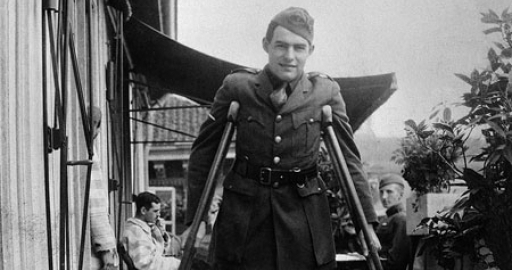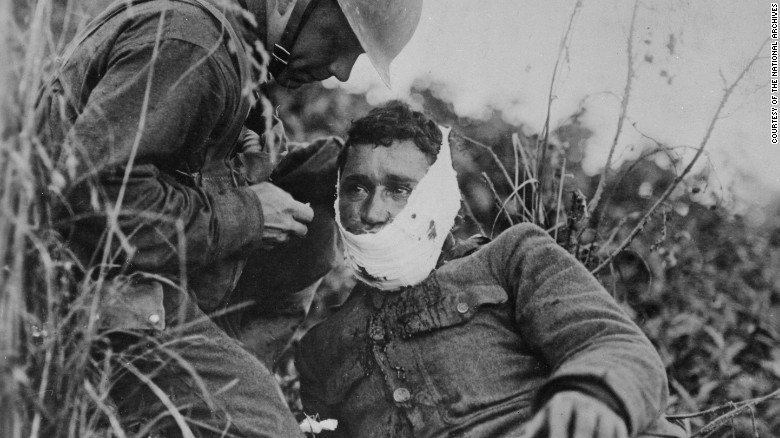Writers, Even Teenagers, Take to the War;
‘A Farewell to Arms.’
Special to the Great War Project.
(10 July) The young Ernest Hemingway will experience the war first hand.
The eighteen-year-old American takes a job as a Red Cross ambulance driver on the Italian Front where in the first days of July a century ago, the Allies take three-thousand Austrian troops prisoner.

Hemingway wounded in Italy.
According to historian Martin Gilbert, Hemingway is “the second American to be hit on the Italian Front, wounded by an Austrian mortar shell on the night of July 8th while handing out chocolate to Italian soldiers in a dug out.”
He was awarded the Italian Silver Medal of Military Valor and taken to a hospital in Milan. “This is a peach of a hospital,” he reported, “and there are about eighteen American nurses to take care of four patients. One of the best surgeons in Milan is looking after my wounds.”

Hemingway in Italy with nurse.
Hemingway was hit several times by shell fragments in the back and leg.
The Italian soldier who was standing next to him was killed.
According to the American account of the incident, before taking care of himself, Hemingway rendered generous assistance to the Italian soldiers more seriously wounded by the same shell explosion.”
Years later he will use these experiences in what became his classic novel of the war, A Farewell to Arms.
Ernest Hemingway is not the only American literary figure to participate in the war. Novelist John Dos Passos also served as an ambulance driver, in France. As did the poet e.e. cummings.
Novelist William Faulkner joined the Canadian Air Force. Poet T.S. Eliot tried to enlist but was rejected. He was judged physically unfit.
The novelist Edith Wharton, according to historian Gary Mead, was in France when the war broke out. She established and funded the American Hostel for Refugees. And she set up the Children of Flanders Refugee Fund.

Gertrude Stein with portrait of her painted by Pablo Picasso.
The writer Gertrude Stein also wrote about her experiences as an ambulance driver for the American Fund for French Wounded, in her book The Autobiography of Alice B. Toklas.
These experiences on the part of young literary figures usually took place in the early years of the war, when there was little or no organized program to participate in the war.
By the summer a century ago the flood of soldiers and the military has swept past the contribution of individual writers.
“By the beginning of July 1918,” writes historian Martin Gilbert, “a million American troops were in France. Their supplies were entering French ports at a rate of 20,000 tons a day. On July 1st showing great bravery, and tenacity, American troops attacked the village of Vaux. Information provided by a local stonemason helped them take the village with a minimum of loss.”
On July 4th a century ago, “American troops were in action at the River Somme once again, alongside the Australians.”
They seized more than a mile of French territory lost to them at previous battles at the Somme. Nearly fifteen hundred Germans were taken prisoner.”

Wounded American soldier in France, 1918.
Reports historian Gilbert: “It was during this attack that the first airborne supply of troops in battle took place, when British aircraft dropped 100,000 rounds of ammunition to the Australian machine gunners.”
The Allies are seizing the initiative.
